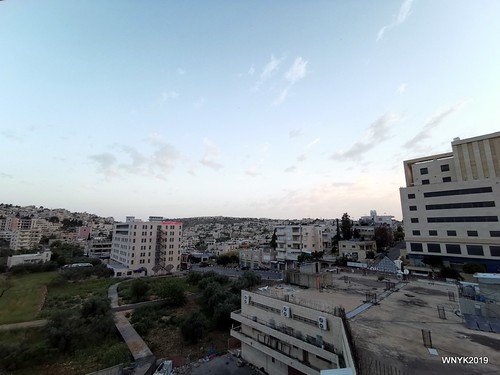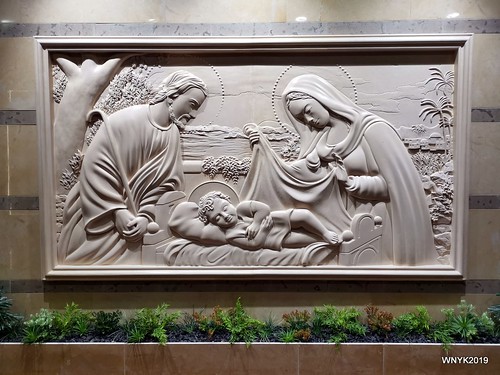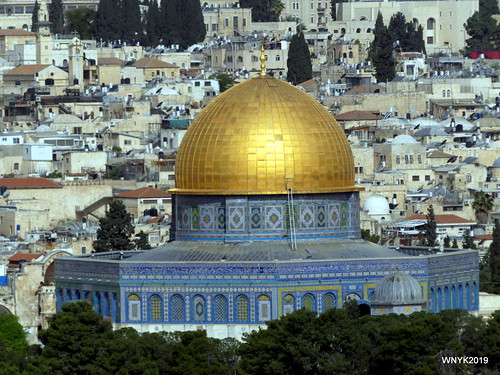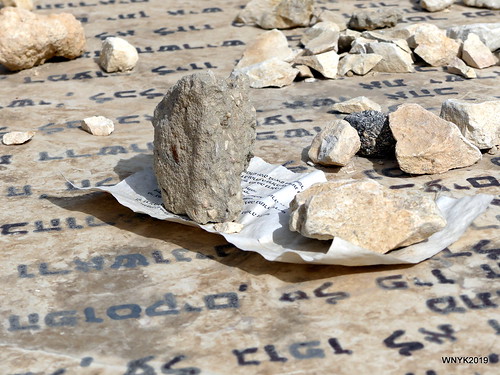Pilgrimage 2.0-5 : Jumping Jerusalem!

The Orient Palace is decorated to be a predominantly Christian pilgrimage hotel. The check-in counter was flanked by statues of the Virgin Mary, and there was a large bas relief of Madonna and Child. But like many establishments catering to Christian pilgrims in the Holy Land, it is owned by Muslims. Other examples include shops selling religious paraphernalia. They probably know more about the merchandise part Christianity than actual Christians. To make a buck, it does not matter. No conflict of interest.

The first place we visited in Jerusalem was the Chapel of the Ascension on the Mount of Olives. Before getting off the bus, Sherry warned us not to buy souvenirs from the Arab street vendors and children. Right outside the chapel was a mosque, a feature at many of the holy sites that we were going to visit. Islam and Christianity has a tangled history in the Holy Land. The chapel is really austere, with little decoration. On the floor is a small framed stone with an imprint of Jesus' right foot as He Ascended into Heaven. The stone had been worn smooth from pilgrims' touch over the ages. Around the compound are several altars from a few different periods.


From there we walked to the next site, the Pater Noster Church (part of a Carmelite Monastery), which actually belongs to France because the land was bought by a French princess in the 1850s. The name of the church comes from the fact that it contains the Pater Noster prayer in 108 languages. Each prayer is fired on a piece of glazed tile and embedded in the walls around the church. Alternately, the church is called the Heart Church, because it contains the heart of the French princess' father. Next to the church is the ruins of the older Byzantine Church of Eleona.


Next we walked up the slope to an observation point to view the Old City of Jerusalem, which is lined by old limestone walls. In the distance, the most imposing building is the Dome of the Rock, with its shining golden dome. Eighty kilograms of gold was donated by King Hussein of Jordan in 1993 to refurbish the dome located in the heart of Temple Mount. Islamic scholars believe that it is the spot where Prophet Muhammad where he started the miraculous Night Journey and ascended to heaven.



Another landmark is the Resurrection Rotunda of the Church of the Holy Sepulchre, and the dome of Al-Aqsa. Based on those landmarks, one can see the rough segregation of the Muslim, Christian, Jew, and Armenian Quarters. A unique feature is the Muslim cemetery metropolis that originated outside the sealed Golden Gate. Across the Kidron Valley, on the Mount of Olives, the Jews bury their dead there. Both have traditions regarding the Apocalypse and the coming of the Messiah, hence the faithful want to be buried there.


Jewish graves are stone boxes with the tombstone laying flat. Visitors do not leave flowers, but put rocks instead. Flowers wilt, but rocks are relatively forever. And there's a hole at the side for memorial candles to be lit. The cemetery on the Mount of Olives has graves dating from the Second Temple period. Continuing down the slope, we arrived at Dominus Flevit, a church dedicated the event from the Gospel of Luke where Jesus becomes overwhelmed by the beauty of the Second Temple and predicting its future destruction, and the diaspora of the Jewish people, wept openly. Hence the church is shaped like teardrop.



Garden of Gethsemane was next with its beautiful olive tree garden. Many were more than a hundred years old, but there was one grand old dame more than a thousand years old. This garden is located beside the Church of All Nations is one of the four claiming to be the real deal. Mass was celebrated at this church. Because the Rock of Agony, part of the bedrock where Jesus prayed before He was arrested (Agony in the Garden) is located in front of the altar, there was a little commotion to clear out the pilgrims for us to proceed.




The Wailing Wall or Western Wall was next. Because it was Friday, the Old City would be choked up for Friday prayers, so the bus just dropped us outside of the Dung Gate, (where we managed to get a view of Al-Aqsa) and we walked in. Sherry showed us the ruined part of the Western Wall to give us an idea of how it looked as part of the Second Temple. Behind the wall is Temple Mount, the holiest place for Jews, but they are not permitted to enter as it is under Islamic control. Jews from all over the world pray at the wall, lamenting the history of their race, and the destruction of the Second Temple.

Petitions are written on pieces of paper and stuffed into the crevices between the ancient stones. As advised by our guide, I performed the ritual ablution using a two-handled natla cup (simpler than what the Japanese do before entering Shinto temples), then picked up a white yarmulke (skullcap) from a public box. Men and women are segregated by a fence. An amazing touching the ancient stones.


Orthodox Jews were all over the place, either standing or sitting, reading the Torah. Some can be seen bowing back and forth, which my guide says is our equivalent of kneeling. Mini Torahs (tefillin) are tied to their foreheads and left arm (closer to their heart) with leather thongs, and some are draped with long cloth.


Lunch was at Kibbutz Ramat Rachel. Another buffet lunch before heading to Dormition Abbey. Dormition Abbey is Benedictine church located on Mount Zion, and its regarded as the place where Mother Mary ended her worldly existence. Up close, it was difficult to make out how the circular building really looks. Sherry brought us straight down to the crypt where there is a wooden statue of a 'sleeping' Mother Mary, surrounded by several unique chapels. Upon exiting, there is a sculpture of a large pine cone in bronze with a surface worn smooth from the touch of pilgrims. The pine cone is actually a symbol of fertility and eternity.




Nearby is the Cenacle or Upper Room, where the Last Supper is believed to have taken place, and where the Holy Spirit alighted on the apostles. The room has a mixture of Christian and Islamic features. On one end, there's a column decorated with pelicans, a symbol of Christianity, on the other there's a mihrab, and Quranic inscriptions on the wall.



Below the Cenacle is King David's empty tomb. Men and women are segregated when going in. Sherry hurried as along as it was the Sabbath, else we wouldn't be allowed to take photos. Nothing much to see, except an Orthodox Jew praying over the tomb.

The last church for the day was the Church of St. Peter in Gallicantu, which means the cock's crow. The Church commemorates St. Peter's repentance after denying Jesus for three times. Beneath the church are several levels of crypts dating back to the Second Temple period. The place is also believed to the Palace of Caiphas, hence Jesus might have been held in one those dungeons.


For our whole stay in Jerusalem, dinner and breakfast were both at the hotel. After we had our fill, it was time to go shopping. Two vans sent us out to the nearby Roman Canal Souvenir shop. The main things to get in Jerusalem are items made from olive wood, and the Jerusalem cross.



Comments
I love looking at the Rabbi with bushy beards. They all look alike to me. Was your trip a special pilgrimage tour organized by your own church?
That's interesting. Should find some photos of that cemetery.
Yeah, the Orthodox Jews look pretty much alike.
The pilgrimage was organized by travel agency with support from the KL Archdiocese.
@TBoy:
Tour cost was RM10,750 for twin sharing.